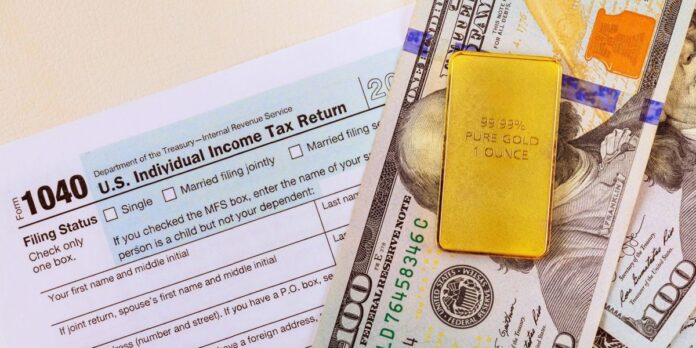Introduction to Taxation on Gold and Silver
Gold and silver bullion, coins, and bars are considered collectibles by the Internal Revenue Service (IRS) in the US. As a result, physical gold and silver, regardless of form, are subject to a higher rate of capital gains tax when sold. This also applies to other precious metals like platinum and palladium.
Understanding Capital Gains Tax
While long-term capital gains typically carry a top bracket of 20 percent, collectibles can be taxed at a higher 28 percent. The total tax an investor owes on the sale of physical gold and silver depends on both their income bracket and the length of time they held the asset. The long-term capital gains tax on physical gold and silver equals the investor’s marginal tax rate, up to a maximum of 28 percent, due to their status as collectibles. This means those in higher tax brackets still only pay 28 percent on long-term gains from physical precious metals sales.
Short-term vs. Long-term Capital Gains
It’s essential to differentiate between short-term and long-term capital gains. The 28 percent maximum applies only to long-term capital gains, which are gains from metals held for more than one year. Short-term capital gains on precious metals held for less than one year are taxed at ordinary income rates. For example, an individual in the highest tax bracket who buys 100 ounces of physical gold at $1,800 per ounce and sells it two years later for $2,000 per ounce would pay 28 percent tax on the capital gains, amounting to $5,600 in income tax on a $20,000 gain. However, if the gold is sold at the same gain just 11 months after purchase, it would be considered short-term capital gains, and the investor would be taxed at 37 percent, owing $7,400.
Taxation on Gold and Silver ETFs
Gold and silver ETFs act similarly to individual stocks, with their taxation based on the ETF’s holdings, the investor’s tax bracket, and the holding period. ETFs that track metals prices provide exposure to physical gold or silver or gold or silver futures contracts, but investing in these does not allow for the ownership of physical gold or silver. ETFs that invest in gold or silver companies provide exposure to gold- and silver-mining stocks, as well as gold- or silver-streaming stocks. Long-term capital gains from selling shares of gold and silver ETFs that hold physical precious metals are subject to a 28 percent maximum federal income tax rate, while those holding stocks are subject to a 20 percent maximum rate. Short-term gains are subject to a maximum federal rate of 37 percent.
Taxation on Gold and Silver Stocks
For gold and silver stocks, long-term gains from selling are subject to the standard 20 percent maximum federal rate, while short-term gains face a maximum federal rate of 37 percent. Unlike physical precious metals and ETFs that hold them, precious metals stocks are not classified as collectibles, resulting in a long-term capital gains tax cap of 20 percent instead of 28 percent. Stocks sold at a loss can be used to offset capital gains when filing income tax.
Reporting Taxes on Physical Gold and Silver Investments
Market participants who sell precious metals in the US for a profit must report that profit on their income tax return. When selling gold and silver investments, there are two sets of reporting guidelines: one for the dealer and one for the investor. Taxes on the sale of gold and silver are not due immediately after the sale and are paid at the same time as a standard income tax bill. Investors report capital gains or losses on Schedule D of Form 1040, detailing transactions on Form 8949, including the holding period. The 28% Rate Gain Worksheet in the Schedule D instructions is used for calculations.
Conclusion
Understanding the taxation of gold and silver investments is crucial for investors to manage their portfolios effectively. Whether investing in physical gold and silver, ETFs, or stocks, knowing the tax implications can help in making informed decisions. It’s also important to follow the correct reporting procedures to ensure compliance with tax laws. Given the complexities, consulting a tax professional can provide personalized guidance tailored to an individual’s investment situation.

